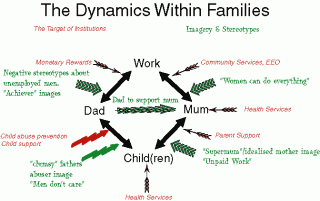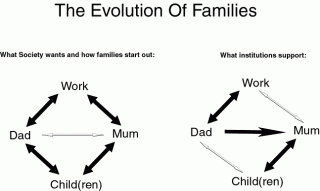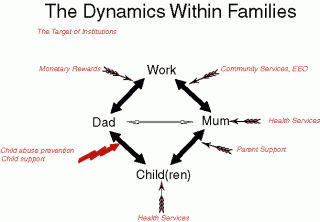Supporting a team approach in parenting: A new vision for Parent Support
Address to the Social Policy Forum Children’s Rights And Families
By Harald Breiding-Buss
National Coordinator
NZ Father & Child Society
October 2000
Introduction: Parents and Society
My own personal experience as a “role-reversed” dad from the time when my children were young babies was that it is not at all easy. Raising children is a challenging task in itself, but it is affected by an array of attitudes and stereotypes about mothers’ and fathers’ proper roles, which makes stepping outside those roles difficult.
As a man I found that there was no infrastructure supporting me as a parent, which I felt comfortable enough using as a father.
My partner, too, found it virtually impossible to access any parenting services as a fulltime working mother.
As work becomes more flexible and living on a single income harder (Callister, 1998), more and more men are looking after children while their wives are working, while being employed themselves or working from home.
The fathers and mothers I see in classes and groups are not lacking in initiative to adopt a team approach, but in support to do so, especially at the time when their baby is little and they are feeling insecure about their roles (Breiding-Buss, 2000).
It is especially during those early months where the attitudes of support organisations and society as a whole can have a major impact on the role division of individual couples.
Society overall seems to have adopted equal shared parenting as their favourite model.
A survey by the Office of the Children’s Commissioner conducted amongst 2000 randomly selected New Zealanders in 1999 found very strong support both for overall concepts of shared parenting as well as equal involvement of father and mother with particular parenting problems [Table 1].
But the same survey also indicated that society feels ambivalent about fathers’ competence in parenting. 45% agreed that “women are better looking after children” – almost the same number as disagreed. I have called this phenomenon the confidence gap of fathers: the gap between social expectations and social trust.
Table 1: New Zealander’s Attitudes to Shared Parenting
Taken from: Julian (1999). Percentage of a sample of 2000 randomly selected New Zealanders
| Agree | Disagree | Not Sure | |
|---|---|---|---|
| “Looking after children is not manly” | 3% | 94% | 2% |
| “Society should expect fathers to take an equal part in parenting” | 92% | 5% | 3% |
| “Women are better at looking after children | 45% | 47% | 8% |
| Both Equally | Mainly/Only Mother | Mainly/Only Father | |
| Discipline | 96% | 2% | 2% |
| Helping with behavioural problems | 94% | 3% | 3% |
| Helping with personal problems | 84% | 11% | 1% |
| Being involved with sons | 79% | 2% | 18% |
| Being involved with daughters | 77% | 22% | 1% |
An indicative study in the Nelson area conducted about a year later gives some clues as to why this is.
Fathers see a conflict between the social expectation of supporting their partners in their mother role and asserting themselves as parents (Chapman et al., 2000; p.8):
“Many of the Dads, when first presented with the survey were unable to comprehend and respond to the questions as was expected. In particular, many of the participants were unable to understand that the survey was about their experiences of services.
They answered for their partners and children. It was as though they were quite unused to considering themselves as a valid recipient of support from child and family services..
When these Dads began to make a shift to that of considering their own needs, many found this a new experience.
During both the survey and the focus groups, many Dads commented that they had never considered parenting issues from the perspective of a Dad, having always considered parenting from the perspective of supporting the mother and child(ren).
Thinking of their own needs as a parent, as well as how these needs could be supported, was a completely new experience for them”
And reflecting my own experiences – and that of many other male facilitators – in classes and groups the same study questioned the idea that men are “naturally” uncommunicative (dito, p21):
“It seems that far from being the silent and distant people who find considerable difficulty in expressing emotion, these men shared their experiences openly and enthusiastically.”
“They talked with considerable interest and passion for their parenting role and they shared stories of vulnerability and pain”
If a favourable environment is supplied, men talk and get involved. But if service providers perceive men to be quiet and distant this may indicate a problem with the service rather than the men.
Outside Influences: How Parents Are Forged Into Particular Roles
Apart from their own personal networks and immediate family, parenting (and other) institutions would have the biggest impact on how parents perceive their roles. Many such institutions are also active to create such personal networks to assist the transformation into the new roles.
Therefore they must be considered as very important in how social stereotypes (or what they perceive as current social stereotypes) are conveyed to the parents.
Role of Institutions
Parents may start out with ideas of (more or less) equal shared parenting, and (more or less) an equal role in breadwinning.
Fathers I talk to in ante-natal classes usually see the first six months or year of the life of their new baby as a transitional period, where the role division in at-home caregiver and out-of-the-home breadwinner is dictated by circumstances such as breastfeeding and the fact that health professionals have liaised predominantly (if not exclusively) with the mother.
However, the mother- and child-focus of health service providers remains and is not replaced at any time with a family-focus or an added father-focus.
Institutions such as the Plunket Society, ParentsCentre, Playcentre and many others also foster the mother-child relationship through encouraging networking between mothers and ‘upskilling’ women into parents.
No such service is available for the father, who falls behind as a recipient of information.
To the contrary, institutions offer more negative affirmation of the father’s role, in targeting them with child abuse prevention methods or chasing them up for child support payments. This is an important qualitative difference: women receive positive affirmation as parents, men receive the threat of sanctions if they fail to their expectations. (Fig. 1.1.).
Separated fathers complain that the Family Court continues this institutionalised role division between mothers and fathers in the case of separation (Julian, 1998; Birks, 1998). Society as a whole appears to agree with them (Julian, 1999).
Each parent’s relationship to work is also supported or encouraged in different ways.
Men’s relationship with work is driven mainly by the monetary reward, for women there are institutions such as the Equal Employment Opportunities Trust or a large array of Community Services to promote their role in the workforce.
Fig. 1.1. :Influence of institutions on role divisions.
Role of Imagery and Stereotypes
Add to that imagery and social stereotypes (Fig. 1.2.). There is pressure on mothers to live up to an idealised image, and modern programmes dealing with, for example, post-natal depression ask the women to analyse such pressures.
But there is also increased acknowledgement of what women do at home, symbolised perhaps by the phrase “unpaid work”
The imagery and stereotypes are again much more ambivalent about the father-child relationship. There is a prevailing image of fathers as abusers, which is very strongly perceived by men as counterproductive (Julian, 1998), and which is conveyed very strongly by government departments, or government-funded institutions.
There are many jokes about the clumsiness of fathers especially with infants (refer to Fig.3 for an example), and there’s at least an equal number of jokes and images conveying the idea that men have to be ‘dragged kicking and screaming into spending time with their children’.
The father-child relationship seems permitted to occur under certain conditions subject to the proven usefulness of the father in other matters. Not the least of this is (paid) work.
There is certainly a strong drive for men to be “achievers” in their jobs, and job advertisements in weekend papers for the more male-dominated professions often pay heed to that (“High levels of energy and enthusiasm”, “Success-Driven”, “Achievement-Oriented”, “Self-starter with minimum levels of supervision” – from job ads in the computer and electronics industry in The Press, Oct 21st, 2000).
There are also very negative stereotypes about men who are unemployed – they are perceived as lazy or “dole bludgers”.
Women are subject to this to a lesser extent, and furthermore there are now more and more images conveying the idea that women can do everything (see the recent blockbuster movie “Erin Brockovic” as an example). No similar images portraying men’s juggling acts between family and work exist.

Fig. 1.2.: Influence of imagery and stereotypes on role division (green) added to the influence of institutions (red).
Desirable Policy Targets
In summary, institutions, imagery and stereotypes link together to provide a very strong emphasis on the mother-child relationship, a strong emphasis on the father-work relationship, a weaker emphasis on mothers and work, and very little (positive) emphasis on father-child.
This is the basis for the confidence gap. Fig. 2 simplifies these trends and takes into account what men perceive as a one-way support role for their partners.

Fig.2: Difference between preferred model and supported model for role division. Black arrows higlight strong relationships, white arrows highlight weak ones. The arrow between “mum” and “dad” in the left graphic is white because the parents may be separated.
The Ministry of Women’s Affairs considers women’s economic independence a high priority (MWA, 1999).
Given how women’s relationship with their work is linked to men’s relationshup with their children it is hard to see how more economic independence for women can be achieved without closing men’s confidence gap at home. This is where progress seems to have stalled at the moment.
What social policy needs to target, therefore, is, in addition to the mother and work relationship, the father and child relationship as well as the relationship between the parents, especially when they are not living together.
Personally I believe we need an entire paradigm shift as far as the homefront is concerned.
Official New Zealand makes no difference between women’s issues and children’s issues, and I think that reflects and reaffirms the idea of children being women’s work, and men’s job being a financial supplier to this relationship.
The Ministry of Women’s Affairs and other government-funded institutions may act against their own goals and targets by maintaining this narrow focus. The government’s goals are well in line with Society’s wishes, and yet the government’s policies probably act to hinder further progress, because they target only one half of the solution.
We need to start thinking about how we can support families as a team without reinforcing traditional roles and without taking choices away from parents.
In an earlier paper I have called for a government taskforce that looks into how shared-parenting friendly the institutions are it funds, and how they can be brought more into line of what parents and society as a whole want. I would like to reaffirm this call here.
Finally, there is an immediate social need for putting more positive emphasis on the father-child relationship, resulting from the numbers of sole fathers and the amount of time men now spend with children alone.
I believe we cannot afford a confidence gap in fathers.
References:
Birks, S (1998) “Judges Can Have The Last Say”, Father&Child #2, March 1998.
Breiding-Buss, H. (2000) “Involving Men in Maternity Services”, Address to PHA Millenium Conference 24-26 July 2000.
Callister, P (1998) “‘Work-rich’ and ‘work-poor’ individuals and families: Changes in the distribution of paid work from 1986 to 1996”, Social Policy Journal of New Zealand, 10, 101-121.
Chapman, P., McIntosh, C., Mitchell, D. (2000) “Real Dads – Real Men: A study of Father’s Experiences of Child and Family Services”; Nelson Marlborough Health Services.
Julian R (1998) “Focus on Fathers”. Office of the Children’s Commissioner.
Julian R (1999). “Fathering in the New Millenium.” Office of the Children’s Commissioner.
Ministry of Women’s Affairs (1999); “Briefing Paper to the Incoming Minister”.
www.mwa.govt.nz/women/brief/index.html





